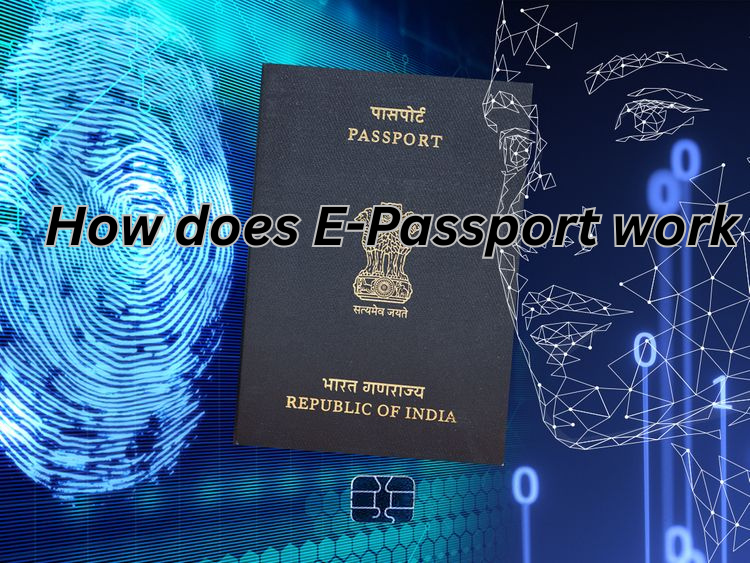RKM-MONK
As the world becomes more linked, travel safety and efficiency have become very important. The E-Passport, which is also called an electronic passport or biometric passport, is a big step forward in the technology used for travel documents. It makes things safer, speeds up the immigration process, and fights identity theft. This talks about what an E-Passport is, how it works, its pros and cons, and what the future holds for it.
Contents
What is E-Passport ??
An electronic microprocessor chip has been integrated into a traditional passport to create an E-Passport. Along with to the personal information included on the passport’s data page, this chip maintains biometric data about the passport the person who holds it such as a digital photo, fingerprints, or iris scans.

How does E-Passport work ??

E-Passport contains
Personal Data : Name, date of birth, nationality, passport number, and date of expiration are examples of personal data.
Biometric information: is usually an electronic picture of the face, though some nations also use iris or fingerprint scans.
Digital signature: Blocks tampering and secures the accuracy and legitimacy of the data.
Using Radio Frequency Identification (RFID) technology, the system reads the chip when a traveler shows their E-Passport at an automated border control or e-gate. The chip’s biometric information is compared to the traveler’s immediate time biometric scan (such as from a facial recognition camera) to quickly and accurately verify identify.
Do current passport holders need to apply for an e-passport?
You can decide to hold off on renewing your passport if it is still valid and you don’t travel abroad very often. However, obtaining an e-Passport is a good idea if you value improved safety, faster immigration processing, or frequent travel.
Before choosing, always review the benefits and regulations unique to your nation with relation to e-passports.
How to apply ??
Check https://www.passportindia.gov.in, the official Passport Seva site.
Register an account using your email address and mobile number to sign up as a new user.
Next, “Apply for Fresh Passport/Re-issue of Passport.”
Fill the application form
Pay Passport fee online
Schedule the appointment at Pass Port seva Kendra. You need to visit at passport seva Kendra after completing varication pass port would be send at the given address .
E-passport fee and charges in India :
| Passport Type | Pages | Validity(years) | Fee(Normal) | Fee(Tatkal) |
| Ordinary Passport | 60 | 10 | 1000 | ₹3,500 (₹1,500 + ₹2,000 Tatkal fee) |
| Ordinary Passport | 36 | 10 | 2000 | ₹4,000 (₹2,000 + ₹2,000 Tatkal fee) |
| Minor Passport | under 18-36 | 5 | 1500 | ₹3,000 (₹1,000 + ₹2,000 Tatkal fee) |
Benefits of E-Passports
- Increased Protection
Because to the chip’s encryption and digital signature, it is very impossible to falsify or change passport 1. information.
Identity fraud and impersonation concerns are decreased with biometric verification.
- More quickly Border Processing
E-gates that operate automatically expedite immigration inspections, cutting down on lines and wait times.
Border controls can be bypassed by travelers with minimal help from humans.
- Global Uniformity
Global interoperability is ensured by e-passports adhering to International Civil Aviation Organization (ICAO) requirements.
Passport information can be safely and effectively shared and verified by nations.
- Travelers’ Convenience
fewer manual checks and paperwork.
increased trust and a more seamless journey.
Problems and Issues
- Concerns about privacy
Concerns regarding data misuse and spying are raised by the storage of biometric data.it is an eye opening concern . - Technical Weaknesses
Possible dangers of RFID chip cloning or illegal reading (skimming).
requires strong shielding and encryption technologies. - Expense and Execution
more expensive to produce than conventional passports.
Upgrades to the border checkpoint infrastructure are required.
Electronic Passports’ Future
E-passports continue to change with trends like:
Adding More Biometrics: For increased accuracy, use palm prints and iris scans.
Mobile Passports: Safely kept digital passports on smartphones.
Connectivity with Additional Travel Documents: simplified the visa and travel permission procedures.
Blockchain Technology: Improving decentralization and data security.
In conclusion
The E-Passport, which combines technology and international collaboration to secure borders and promote global movement, is a significant advancement in travel security and efficiency. Future travel experiences should be even more seamless and safe, even though there are still obstacles to overcome.
Understanding and utilizing E-Passport technology is essential for both governments and tourists to navigate the mod.
